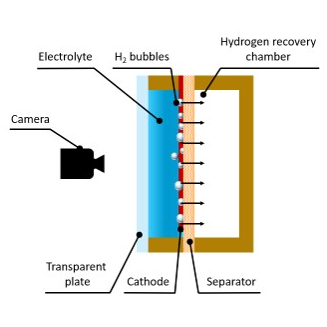Bachelor/Master Project/Thesis: Hydrogen transport through hydrophobic separators for more efficient microbial electrolysis cells

Currently, a high energy consumption is required to remove all the organic compounds during the treatment of wastewater streams. However, the energy stored in the chemical bonds of these organic compounds is largely unused. The innovative concept of microbial electrolysis cells (MECs) can harness the chemical energy contained in the organic matter of wastewater streams to produce high valuable compounds, such as hydrogen, while reducing the concentration of organic acids. Unfortunately, methanogenic bacteria, typically present in wastewater streams, serves as an unwanted sink for the hydrogen produced at the cathode of the MEC, thus reducing hydrogen recovery. To increase the yield, it is necessary to implement hydrogen harvesting strategies to remove it from the medium as soon as it is produced.
The new concept of gas diffusion electrodes would enable efficient collection of the produced hydrogen in single chamber MECs, see Figure. In order to assess the capabilities of the gas diffusion electrode concept to remove hydrogen from an aqueous system, we use a small optically accessible reactor volume with a hydrophobic separator wall as mass transfer interface for hydrogen. A voltage beyond the hydrogen evolution potential is applied to an inserted stainless-steel wire. As a consequence, hydrogen bubbles will emerge on the wire as well as in contact with the proximate interface material. After removing the potential from the electrode, the hydrogen bubbles will shrink over time. The mass transfer due to either dissolution into the liquid or due to the transport through the membrane causes the size decrease. A camera system observes the bubble shrinkage. Digital image analysis allows to deduce the decreasing bubble volume over time. The resulting mass transfer rates for the dissolution and the membrane transport will allow to establish a proof concept study.
Main objective/Research questions:
Characterization of hydrogen mass transfer through a hydrophobic separator under different hypobaric conditions
Secondary objectives/Learning goals:
- Characterization of hydrogen mass transfer through a hydrophobic separator under different hypAssembly and operation of an abiotic electrolysis cell
- Operation of a camera system to record the absorption of hydrogen bubbles
- Post-processing image analysis to evaluate the mass transfer rates of hydrogen depending on the pressureobaric conditions
Begining from:
November 2023
Language:
English
Period of time:
Bachelor Project / Thesis: 3 months
Master Project / Thesis: 6 months
References:
Lu, L., Hou, D., Wang, X., Jassby, D., & Ren, Z. J. (2016). Active H2 harvesting prevents methanogenesis in microbial electrolysis cells. Environmental Science & Technology Letters, 3(8), 286-290.
Contact:
Dr. Óscar Santiago Carretero (santiagoprotect me ?!uvt.uni-bremenprotect me ?!.de)
Dr.-Ing. Ulrich Mießner (miessnerprotect me ?!uvt.uni-bremenprotect me ?!.de)

![[Translate to English:] Zur Startseite des Fachgebiets Umweltverfahrenstechnik](/fileadmin/user_upload/fachbereiche/fb4/uvt/LOGO/UVT-Logo-Webseite.png)